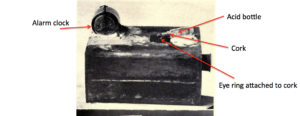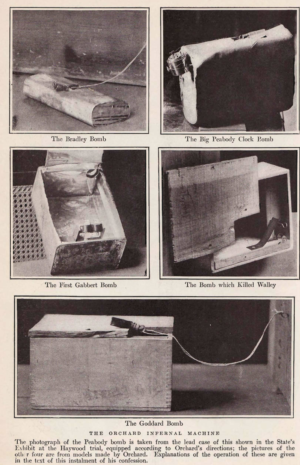A colleague put me on the trail of some interesting devices used in Colorado at the turn of the last century and I’ve found some interesting details about some very unusual IEDs. In balancing the interests of readers and my natural disinclination to inspire any bomb makers I’m going to be a little vague about certain aspects of the design, so bear with me.
The perpetrator of the attacks was a man who called himself “Harry Orchard” but he had an awful lot of other aliases. Orchard was involved in what are now called the Colorado Labor Wars, a struggle between mine owners and miners in Colorado in 1903 and 1904.
The dispute became more and more violent, and in that time and in that industry explosives and knowledge about their use was easily available. Harry Orchard first became embroiled with this as a striker and then as a bodyguard to the miner’s leadership. He was a man with few scruples at the time.
IEDs had been used prior to 1903 by both sides – the mine owners had blown up the offices if a “Private Assay Office’ which catered for miners taking gold out of the mine for private sale – a practice called “high grading”. And a mine workers association had blown up a mill in 1899. There were other incidents using explosives.
Orchard may have worked for both sides of the dispute – planting and laying IEDs in support of miners and also, for pay, for the mine owners as provocative acts. In one attack Orchard assassinated the former Governor of Idaho, Frank Steuenberg. There are a few sources about the various attacks that readers can find but for this post will concentrate on his IEDs. The IEDs were constructed in a way that makes me think he was not an experienced “blaster, with experience from the mines. In principle most of his devices used a very unusual and dangerous initiation system. This largely involved using a bottle of acid, placed on its side over a sensitive component in an explosive train. The acid bottle had a cork in it, and the cork was attached to fishing line. Orchard then created a number of mechanisms to “pull” the cork, releasing the acid, which caused the explosion.
- To create a command-initiated device, he ran the fishing line to a safe spot, and waited for his target to approach, then physically pulled the line, puling the cork from the bottle.
- To create a booby trap, victim-operated device, he stretched the fishing line across the likely path of a victim, leaving the IED hidden beside the path.
- To create a timed IED he attached the fishing line to the “key” at the rear of an alarm clock. When the alarm sounded (Orchard removed the bell) the key which wound the alarm element rotated, and wound the fishing line in, eventually puling out the cork from the acid bottle.
Orchard had a couple of other designs:
- One used a pistol, aimed at explosives with fishing line attached to the trigger – for both a command pull and for a booby trap.
- Another device was a handful of blasting caps wrapped in burlap and then pitch so it eventually looked like a lump of coal, then the device was thrown onto the coal bunkers.
Here are some pictures of IEDs which he re-created as part of his confession.

This was the device used in the Steuenberg attack – but Orchard adapted it to operate by tripwire, leaving the clock element unused.

Orchard’s confession is available online –if you’d like details of where to find it let me know – but because it has detailed description of how he constructed the devices I won’t post it publicly.

Orchard was certainly one of, if not the first, to effectively utilize dynamite as the main ingredient in his many IED's. Pretty simple but effective devices although malfunctions occurred now and then. Thanks for the article.
Link to a little more about the bombs and Haywood trial evidence: http://steunenberg.blogspot.com/2009/05/evidence-from-haywood-trial-on-display.html